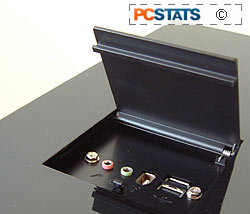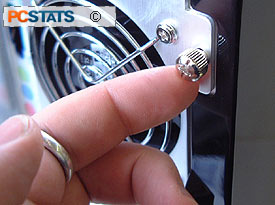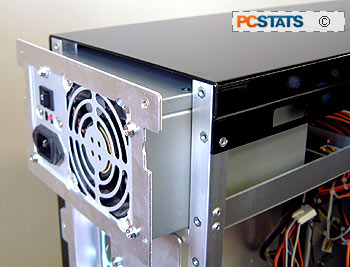 With all the multimedia devices on the market it only
makes sense for case manufacturers to allow you to attach devices without having to reach around to
the rear of your PC. Instead of placing the ports on the front bezel, which would
definitely take away from the WaveMaster's elegant looks, CoolerMaster hide them on the top of the
case, behind a small trap door.
With all the multimedia devices on the market it only
makes sense for case manufacturers to allow you to attach devices without having to reach around to
the rear of your PC. Instead of placing the ports on the front bezel, which would
definitely take away from the WaveMaster's elegant looks, CoolerMaster hide them on the top of the
case, behind a small trap door.
It's different, and in our opinion a clever move. There you'll find
a headphone and microphone jack, a lone IEEE 1394 port, as well as two USB
ports. When you're not using them, simply press down on the small aluminum flap and it
locks right into place hiding everything.
If you'd
rather have a fan exhausting hot air out of
the case than a bunch of ports, you'll appreciate the fact that Coolermaster include an adaptor
so you can do just that.
 The rear of the
WaveMaster case is pretty busy with all the thumbscrews, but everything is accessible. Almost
all the panels are attached to the case with thumbscrews (aside from the
drives). The default rear I/O shield is colour coated as well as labelled with
pictures so end users shouldn't have any problems installing devices there. If
your motherboard requires a custom shield don't worry, the default one pops off
quite easily.
The rear of the
WaveMaster case is pretty busy with all the thumbscrews, but everything is accessible. Almost
all the panels are attached to the case with thumbscrews (aside from the
drives). The default rear I/O shield is colour coated as well as labelled with
pictures so end users shouldn't have any problems installing devices there. If
your motherboard requires a custom shield don't worry, the default one pops off
quite easily.
As with most other high end cases the WaveMaster does
not come with a power supply. And no, I don't think that's
a bad thing.
Look at it this way, CoolerMaster allow
you to customize the WaveMaster case, and indeed your system, to your needs. It would just be
counter productive to buy a nice new case, only to rip out the power supply it comes
with and replace it with a higher wattage, or lower noise model that you've already
have decided to get. This way, the consumer doesn't get stuck paying for a low wattage power supply
they don't want.
 Once you get settled
with the WaveMaster, the first thing you'll want to do is install a power supply
in it. Right now I'd recommend you shoot for a power supply made for low-noise
operation rather than one whose only attribute is high watts (300W is really
sufficient for almost everyone). This is the trend the market is going towards
anyway, and if you decide to specifically buy low noise components (heatsink,
videocard, hard drives & fans) in the future, at least you won't be stuck
with a loud power supply rattling away in the back. For some help deciding on
power supplies, check out the models PCStats has reviewed.
Once you get settled
with the WaveMaster, the first thing you'll want to do is install a power supply
in it. Right now I'd recommend you shoot for a power supply made for low-noise
operation rather than one whose only attribute is high watts (300W is really
sufficient for almost everyone). This is the trend the market is going towards
anyway, and if you decide to specifically buy low noise components (heatsink,
videocard, hard drives & fans) in the future, at least you won't be stuck
with a loud power supply rattling away in the back. For some help deciding on
power supplies, check out the models PCStats has reviewed.
Whether or not you decide on an aluminum power supply or a plain steel one is up to you. Since the WaveMaster appears to have a largely un-anodized internal aluminum frame - the black aluminum sections are obviously anodized or they wouldn't hold the dye. On the inside of the case, its a different situation and the frame will probably create an anodic reaction with steel over time, to some respect. So, don't be too surprised if you notice oxidation of steel components down the road.
To install the power supply you must first
attach the small aluminum bracket included with the case to the power supply, then you can
slide the power supply & bracket into the WaveMaster chassis and lock it into place with some
regular case screws.
The nice thing
about this setup is that the power supply goes into the case irregardless of whether the side panels are
on. We've seen other aluminum cases where such rear-mounting brackets were under the tabs of
the side panels, making for a tedious set of steps any time a power supply was being
installed, or replaced.
